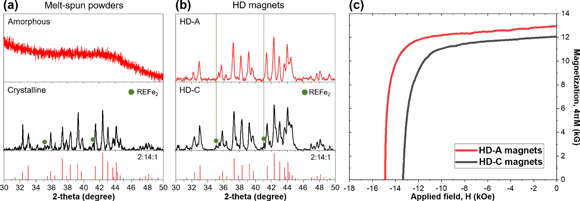KIMS researchers develop rare-earth-reduced permanent magnet
April 27, 2022

Researchers from the Department of Magnetic Materials in the Powder Materials Division at the Korea Institute of Materials Science (KIMS), a government-funded research institute under the Ministry of Science and ICT, have reportedly succeeded in developing rare-earth-reduced permanent magnet that can achieve the commercial magnet (grade 42) level of performance while reducing the amount of neodymium (Nd) rare earth by approximately 30%.
Neodymium is expensive with an unstable supply chain, but is essential for manufacturing rare earth permanent magnets. In order to develop a neodymium-reduced permanent magnet, the content of cerium (Ce), an inexpensive element, has to be increased, instead of reducing the content of neodymium. Until now, with the increased content of cerium, it was not able to prevent the deterioration of the magnetic properties. The research team focused on clarifying the cause and mechanism of the deterioration of the magnetic properties caused by the increased cerium content, and are said to have successfully solved the problem by controlling atomic-scale microstructure.
The researchers discovered that unnecessary magnetic particles were formed in the existing manufacturing process, which are the cause of the deterioration of the magnet’s microstructure and magnetic properties. They improved the microstructure of magnets and enhance magnetic properties to prevent the formation of unnecessary magnetic particles by suppressing their atomic diffusion of them.
They also applied the melt-spinning method and the hot-deformation method, which have very fast cooling velocity compared to the conventional process, to the manufacturing process of rare-earth-reduced precursors and permanent magnets, respectively. As a result, they succeeded in optimising the microstructure of the magnet by suppressing the formation of unnecessary magnetic particles. In addition, they were able to simultaneously improve the residual magnetism and coercive force, which are the main properties of permanent magnets. As the residual magnetism and coercive force are in a trade-off relationship, the technology that improves both main properties is very useful and valuable.
Dr Kim Tae-Hoon, a senior researcher at KIMS who co-led the research team, commented, “When the technology is commercialised, it will simultaneously solve the resource problems and material, parts, and equipment issues of the domestic rare earth permanent magnet material market. This is only the beginning. With further research in the future, we will spare no effort to lead the development of the domestic rare earth permanent magnet industry.”
This research was supported by the material technology development project of magnetic powder with performance modified composite magnetic structure, a fundamental research project of KIMS and funded by the Ministry of Science and ICT.
The research results were published in Scripta Materialia titled ‘High-performance Ce-substituted) (Nd0.7Ce0.3)-Fe-B hot-deformed magnets fabricated from amorphous melt-spun powders’. It is available here.














